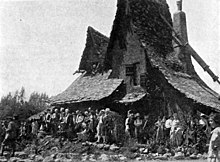Spadena House
| Spadena House | |
|---|---|
 Spadena House, 2011 | |
 | |
| Former names | Willat studio building |
| Alternative names | The Witch's House |
| General information | |
| Type | Private home |
| Architectural style | Storybook |
| Location | Beverly Hills, California |
| Address | 516 Walden Drive Beverly Hills, CA 90210 |
| Coordinates | 34°4′8″N 118°24′39″W / 34.06889°N 118.41083°WCoordinates: 34°4′8″N 118°24′39″W / 34.06889°N 118.41083°W |
| Completed | 1921 |
| Renovated | 2006– |
| Client | Irvin Willat |
| Owner | Michael J. Libow |
| Technical details | |
| Floor area | 3,500 square feet (330 m2) |
| Design and construction | |
| Architect | Harry Oliver |
The Spadena House, also known as The Witch's House, is a storybook house in Beverly Hills, California. Located on the corner of Walden Drive and Carmelita Avenue, it is known for its fanciful, intentionally dilapidated design, and is a landmark included on tours of the area.[1][2][3]
History[]

The house was designed by Hollywood art director Harry Oliver, who went on to play a major role in Storybook architecture. Oliver was a Hollywood art director who worked on more than 30 films between 1919 and 1938 as art director, art department, and set decorator.[4] It was originally built in 1921 to serve as the offices and dressing rooms for Irvin Willat's film studio in Culver City,[5] and was moved to its present location in 1926.[5][6] The converted private home, with its pointy, lopsided roof, tiny windows and stucco with a distressed paint job were then surrounded by an intentionally overgrown English-style garden and a moat-like pond.[1]
The first residents of the 3,500 square feet (330 m2) home, the Spadena family, lent the house their name. A second family moved in and renovated the interior in the 1960s, making some exterior alterations including a skylight visible from certain angles.[1][7] The moat began leaking under the second family's ownership and they filled it with soil, and planted a garden.[3] By the time the house came on the market again in 1997, it had fallen into disrepair. Because of the value of its prime location, it was unable to immediately find a buyer uninterested in a teardown of the property. Consequently, Michael Libow, a real estate agent, who did not want to see the home demolished, purchased it and began a gradual renovation. After tall, black fencing was initially placed around the lot, the owner received hate mail from people who thought he was going to tear it down. Relief came to all when Libow restored and enhanced the original vision of Oliver. The home is now listed as protected Landmark Number 8 in the City of Beverly Hills. [1]
Legacy[]

Architect Charles Willard Moore once described the building as the "quintessential Hansel and Gretel house."[3] The residence appears in movies including 1995's Clueless.
The home has been called a precursor to Walt Disney's concept of Imagineering, whereby stage sets become fully realized environments.[7]
References[]
- ^ a b c d Hobart, Christy (January 13, 2005). "Life within a fairy tale". Los Angeles Times. Retrieved July 20, 2009.
- ^ Spadena House, Southwest Airlines Travel Guide, Accessed July 20, 2009. Archived July 26, 2011, at the Wayback Machine
- ^ a b c Waterman, Pam (February 20, 1994). "Innovative or Wacky, Owners Call Them Home". Los Angeles Times. Retrieved July 20, 2009.
- ^ Kreuzer, Nikki "Offbeat L.A.: Storybook Architecture in Los Angeles", The Los Angeles Beat, February 14, 2013.
- ^ a b Busby, Marquis (November 1929). "Ghostly Studios of Yesterday". Photoplay magazine: 42–4, 99–100.
- ^ Wanamaker, Marc (2005). Early Beverly Hills. Arcadia Publishing. p. 99. ISBN 9780738530680.
- ^ a b Betsky, Aaron (December 24, 1992). "The 'Witches' Cottage': A Realized Fairy-Tale Fantasy in Beverly Hills". Los Angeles Times. Retrieved July 20, 2009.
- Houses in Beverly Hills, California
- Houses completed in 1921
- Novelty buildings in California
- 1921 establishments in California
